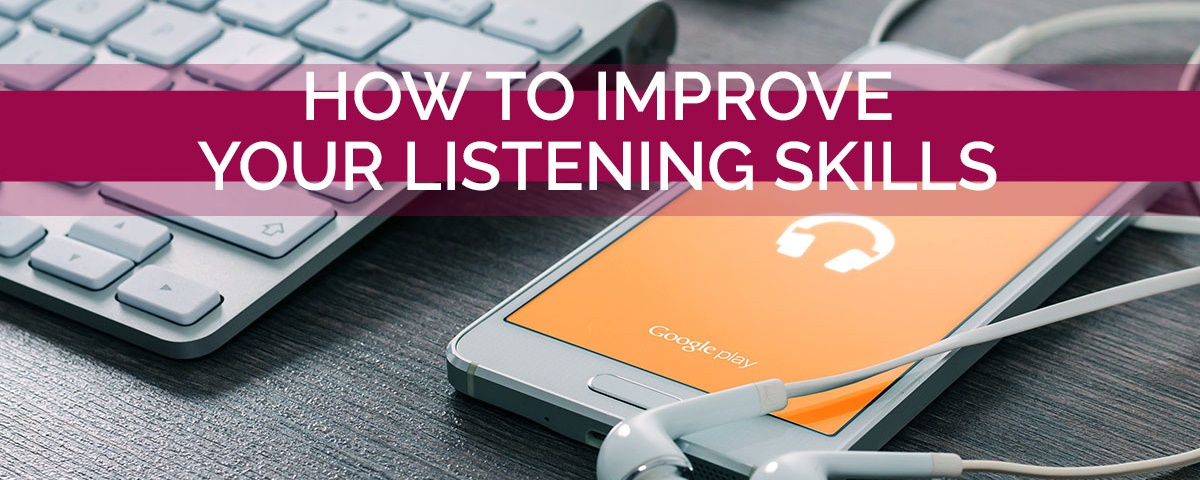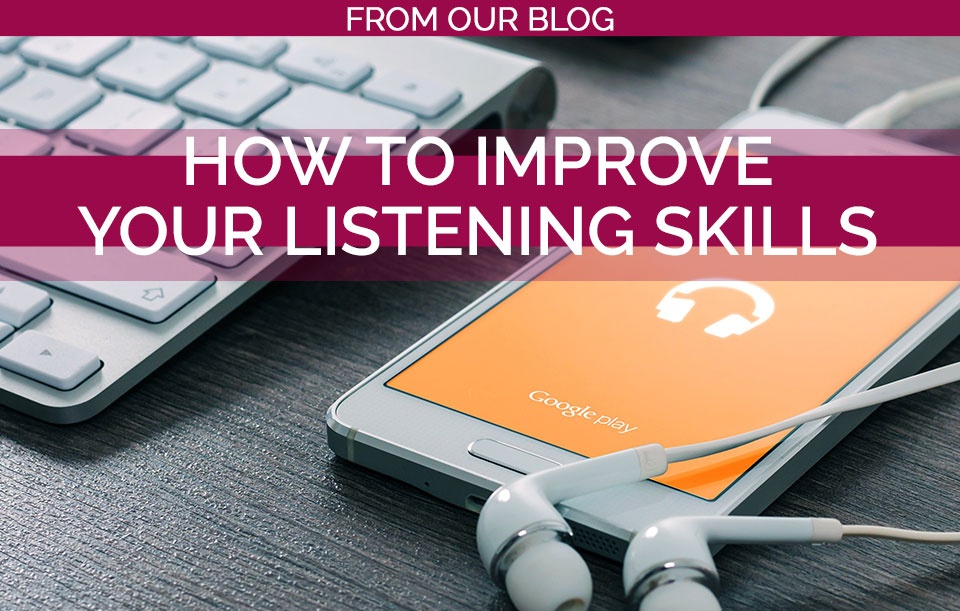How to expand your vocabulary
07/03/2020The order of adjectives in English
19/01/2021
M
y students always ask me how to improve their listening comprehension skills. It goes without saying that understanding a written text is much easier than a speech, a podcast or a real-life conversation partner.
We must remember that there are two types of listening: active listening (i.e. aimed at understanding everything we are listening to by making a constant and indeed ‘active’ effort) and passive listening (i.e. listening to podcasts in the background while doing another activity, without concentrating on understanding everything that is being said, but with the aim of training your ear to the sounds of the foreign language).
Both types of listening are important and recommended. However, in this blog post I will refer only to active listening and I will explain step by step a method to effectively practise active listening. I will give you some advice that has proved to be very useful for my students and has helped them to considerably improve their listening comprehension skills.
Why is listening comprehension more difficult than written comprehension?
W
e should consider that most of the difficulties in understanding an oral passage compared to a written text mainly arise from these three factors (in addition to psychological factors related to anxiety):• In the case of a written text time works in our favour: we can read an unclear sentence twice, reflect on the meaning of a word or phrase, possibly consult a dictionary. But in the case of an oral speech, whether read or improvised, we have to understand it immediately.
• Very often native speakers or people with a good command of the language tend to connect words (in English it is called ‘connected speech’). Therefore, in some cases, the speech can be perceived as a stream of words and we may have difficulty in separating each single word in a sentence. As a result, if we cannot identify and recognise words we can’t understand their meaning. We may even think that the speaker is using a word we have never heard before when in fact it is a term we already know and we simply do not ‘recognise’ (perhaps we pronounce it incorrectly and do not identify it in the speech while the speaker pronounces it correctly).
• Finally, the speaker's accent can be an additional difficulty if they have a strong regional accent, are foreigners or simply speak very quickly and do not articulate properly (not to mention any external problems, for example, in the case of a telephone conversation or a video call with poor quality audio).
So how can I improve my listening skills?
F
irst of all, you should try to be as exposed as possible to the language you are learning. Try to
immerse yourself in the language by listening to podcasts, news programmes or watching videos on topics you like. In another
post in this blog we talked about how to effectively use films and TV series to improve our listening skills.
In this blog post I will give you
practical step-by-step instructions to do an effective listening comprehension exercise.
1 - Select the topic and choose the podcast or audio file to work on (without looking at the transcript and, of course, without keeping it before your eyes during the listening exercise!)
2 - Before clicking on the ‘play’ button and listening to the audio file, you must prepare yourself. I suggest doing a short brainstorming session (max. 15 minutes). Think of words or phrases that might be used in the test you are about to listen to, use a dictionary to look up the translation of some words or phrases that might come to your mind only in your mother tongue and not in the target language and which might be useful to talk about the chosen topic.
In this way you will create a small glossary that will also be very useful to expand your vocabulary. In the post on expanding vocabulary we talked about the importance of learning words and phrases by memorising them in their context to remember them more easily. The preparation will certainly help you to approach the listening exercise in a more relaxed way and you will surely definitely have learnt some new terms or expressions which may not have been used in the text you listened to, but which may be useful in the future.
3 - Listen to the audio file for the first time, trying to note down both the structure and the content of the text without focusing on single words, but on the general meaning of the speech. For example, it is useless to jot down a date or a figure if you can’t relate it to the speech because you didn’t understand what it referred to. I suggest writing down the main ideas of the text because remembering a text without notes is an additional difficulty. These notes don't necessarily have to be in the foreign language - use your mother tongue and don't write whole sentences, but only a few key words or even small symbols that will only jolt your memory and help you remember what has been said in the text.
4 - Now listen again to the audio file once or twice more to understand more information about the content of the text. You can divide the text into smaller sections (depending on the structure you identified during the previous listening session). Listen to a few sentences at a time, pause the audio, get your thoughts in order and see if you understand the main ideas. If necessary, listen to this passage again, focusing on the content now that the structure of the text is clear. Then proceed in the same way with the remaining sections of the text.
At this point, after having listened to the audio file about three times, you should have understood the main ideas of the text. If so, you can go directly to point 8, otherwise, if you are still experiencing difficulties, follow these three points:
5 - If you have a lot of difficulties and you can't understand several sections of the audio file, you shouldn't keep on listening to the audio file endlessly. In fact, your sense of frustration will only increase and you won't understand much more each time you listen to it. If you are doing the exercise on your own and can't use other options (e.g. a teacher may read the text more slowly or rephrase some of the most difficult sections of the text to help you understand them) you can try to transcribe the parts of the text that seem more difficult. To do that, listen to a couple of words and write them down on a piece of paper, listen to them again and continue to transcribe the difficult sentences, read them and see if your comprehension is made easier. Remember that transcription is a very time-consuming activity: even professionals who transcribe texts for work consider that it takes at least 6 minutes to transcribe only one minute of the original text!
6 - Many textbooks with listening comprehension exercises and some websites including podcasts contain exercises to test the comprehension of audio files. Some types of exercises consist of answering questions about the text and help you to easily identify the main ideas of the text, while other exercises include, for example, the typical ‘gap-fill’ exercise to be completed with missing words. In my opinion, this exercise is very useful when you have listening comprehension difficulties because most of the text is under your eyes - a kind of transcript - and you only need to identify a limited number of words to complete the text.
Example of a ‘gap-fill’ exercise
7 - As an alternative to the transcript you can make (point 5) or to additional exercises to check your understanding of the text (point 6), you can consult the transcript of the text which is generally provided in all textbooks or on the different websites containing podcasts. Read the transcript, note down the words which you were stuck on and you will see that, in most cases, these text passages are not so difficult. As mentioned at the beginning of this blog post, often the difficulty we encounter in listening comprehension lies in the fact that words are connected together when the speaker talks fast and we do not recognise each individual word in their speech. If there are unfamiliar expressions or words, use a dictionary to understand the meaning of an unclear sentence. Transcription should always be your last resort: doing a listening exercise and reading the written text because you can't understand the passage is a bit like throwing in the towel and giving up. However, it is true that if a passage is difficult, you must be able to somehow complete the exercise and move on.
Example of podcast with transcript
8 - Good! Now you have understood the text well enough. Some details may still be unclear and, perhaps out of curiosity or to remove a doubt, you may want to look quickly at the transcript of the text (focusing only on the parts where you encountered difficulties). Now listen to the full audio file one last time, from beginning to end, without the transcript and without looking at your notes: everything should be understandable and clear!
9 - This is the most important step! Download the audio file and create an archive on a USB stick or a folder on your computer in which you will collect all the audio files you have listened to and for which you have completed the listening exercise following these recommended guidelines. Then listen to these audio files regularly (at least twice a month). Each time you listen they will seem more comprehensible and you will also consolidate your knowledge of the vocabulary they contain, which you may have looked up in the dictionary and included in your vocabulary notebook.
Some useful websites to improve your listening comprehension
H
ere are two websites that I like very much where you can find free podcasts that are very useful to practice listening comprehension in English. Both websites offer podcasts with transcripts and are suitable for students with a pre-intermediate or intermediate level:
• Listen a minute (one-minute podcasts including exercises)
• BBC - 6 Minute English (6-minute podcasts)
A few more tips…
L
istening comprehension exercises are difficult so put yourself in the best position (and with the right mind set) to do them in the best possible way:
• Avoid any kind of distraction. If you aren’t taking notes, you can also close your eyes to focus only on the speaker's voice. Doing an active listening exercise in a foreign language while driving or ironing your clothes is quite useless!
• Use earphones instead of speakers for better sound quality.
• Don't turn up the volume too loud. It's a normal and natural reaction when we don't understand what we're listening to, but try to avoid it also because the sound quality often gets worse when you turn up the volume!!
• Don’t keep the transcript at hand. It's the same thing as subtitles for films: if the transcript is displayed on the PC screen we make a conscious effort not to drop our eye on it - and this takes away energy that we should use to listen to the speaker's voice! Keep only a blank sheet of paper and a pencil in front of you and don’t display the written text on your PC screen.
• Always complete a listening exercise in a reasonable amount of time. Don’t listen 20 times in a row to the same audio file that you aren’t understanding - but rather consult the transcript and finish the exercise. As recommended above, you will listen to this audio file again in the following days and each time you will understand a little more! Completing an exercise is very important on a psychological level.
• Quality is more important than quantity. As for everything else, doing a listening exercise quickly and badly (e.g. reading the transcript straight away or ‘listening’ to the audio file while reading the transcript) with the aim of listening to a large amount of podcasts is really of little use. It is better to do an effective listening exercise for only 2 minutes a day rather than to listen to 10 audio files quickly - and partially understanding them or keeping the transcript in front of your eyes.
• Don't get discouraged! Listening comprehension is the most difficult skill to improve, especially if you do not live in the country of the language you are learning. As Desmond Tutu wisely said ‘There is only one way to eat an elephant: a bite at a time!’ - bite after bite you will succeed!
This blog post is also available in French and Italian. Click on the flag on the top right to change the language.















